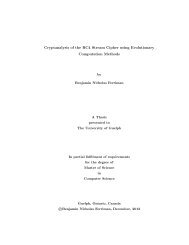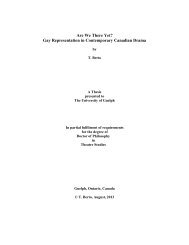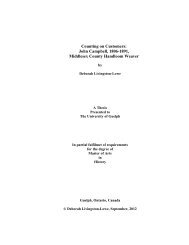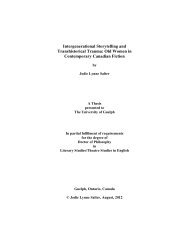THESIS - ROC CH ... - FINAL - resubmission.pdf - University of Guelph
THESIS - ROC CH ... - FINAL - resubmission.pdf - University of Guelph
THESIS - ROC CH ... - FINAL - resubmission.pdf - University of Guelph
You also want an ePaper? Increase the reach of your titles
YUMPU automatically turns print PDFs into web optimized ePapers that Google loves.
4.4.3 ME<strong>CH</strong>ANICAL PROPERTIES<br />
Mechanical properties <strong>of</strong> SPI films were analyzed in different relative humidity as shown<br />
in Table 4.4. With the increase in humidity, the tensile strength and elastic modulus drastically<br />
decreased whereas elongation increased (Figure 4.9, and Figure 4.11). Films exhibited highest<br />
tensile strength and elastic modulus at 11% RH but were extremely brittle. Specimens tested in<br />
the MD had overall higher tensile strength than specimens tested in the TD, as expected. This<br />
suggests similar characteristics to synthetic resins whereby alignment <strong>of</strong> polymer chains in the<br />
MD increases tensile strength in comparison to TD. The increase <strong>of</strong> RH from 11% to 43% RH,<br />
resulted with an increase in elongation (Figure 4.10), but further increase in RH did not<br />
significantly change with specimens tested in the MD. In the TD, a similar positive correlation<br />
could be observed with greater elongation values seen at 84% RH. However, increased<br />
variation <strong>of</strong> results caused a higher degree <strong>of</strong> error. This error can be attributed to the alignment<br />
<strong>of</strong> microscopic holes in the MD, where premature failure is more prevalent for films under<br />
tension in the TD. These results indicate that SPI films are very sensitive to RH leaving it<br />
undesirable for use in water sensitive applications. These trends are comparable to the SEM<br />
findings whereby defects in the film were more pronounced for films exposed to increased RH.<br />
With the combination <strong>of</strong> defects and increased chain mobility from water plasticization<br />
(Kokoszka et al. 2010), mechanical strength should decrease. With the increase in RH, SPI<br />
films exhibited behaviour ranging from rigid, semi rigid to s<strong>of</strong>t plastics. Similar trends were also<br />
found with Zhang et al. (2001) who extruded thick SPI sheets (0.35 to 1.5 mm).<br />
37

















